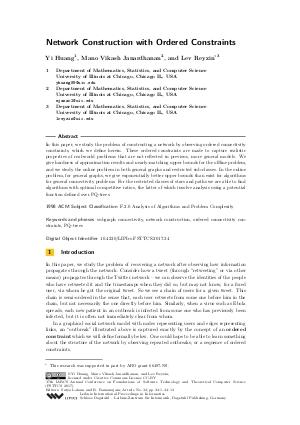Network Construction with Ordered Constraints
Authors Yi Huang, Mano Vikash Janardhanan, Lev Reyzin
-
Part of:
Volume:
37th IARCS Annual Conference on Foundations of Software Technology and Theoretical Computer Science (FSTTCS 2017)
Part of: Series: Leibniz International Proceedings in Informatics (LIPIcs)
Part of: Conference: IARCS Annual Conference on Foundations of Software Technology and Theoretical Computer Science (FSTTCS) - License:
 Creative Commons Attribution 3.0 Unported license
Creative Commons Attribution 3.0 Unported license
- Publication Date: 2018-02-12
File

PDF
LIPIcs.FSTTCS.2017.34.pdf
- Filesize: 0.52 MB
- 13 pages
Document Identifiers
Subject Classification
Keywords
- subgraph connectivity
- network construction
- ordered connectivity constraints
- PQ-trees
Metrics
- Access Statistics
-
Total Accesses (updated on a weekly basis)
0PDF Downloads0Metadata Views
Abstract
In this paper, we study the problem of constructing a network by observing ordered connectivity constraints, which we define herein. These ordered constraints are made to capture realistic properties of real-world problems that are not reflected in previous, more general models. We give hardness of approximation results and nearly-matching upper bounds for the offline problem, and we study the online problem in both general graphs and restricted sub-classes. In the online problem, for general graphs, we give exponentially better upper bounds than exist for algorithms for general connectivity problems. For the restricted classes of stars and paths we are able to find algorithms with optimal competitive ratios, the latter of which involve analysis using a potential function defined over PQ-trees.
Cite As Get BibTex
Yi Huang, Mano Vikash Janardhanan, and Lev Reyzin. Network Construction with Ordered Constraints. In 37th IARCS Annual Conference on Foundations of Software Technology and Theoretical Computer Science (FSTTCS 2017). Leibniz International Proceedings in Informatics (LIPIcs), Volume 93, pp. 34:1-34:13, Schloss Dagstuhl – Leibniz-Zentrum für Informatik (2018)
https://doi.org/10.4230/LIPIcs.FSTTCS.2017.34
BibTex
@InProceedings{huang_et_al:LIPIcs.FSTTCS.2017.34,
author = {Huang, Yi and Janardhanan, Mano Vikash and Reyzin, Lev},
title = {{Network Construction with Ordered Constraints}},
booktitle = {37th IARCS Annual Conference on Foundations of Software Technology and Theoretical Computer Science (FSTTCS 2017)},
pages = {34:1--34:13},
series = {Leibniz International Proceedings in Informatics (LIPIcs)},
ISBN = {978-3-95977-055-2},
ISSN = {1868-8969},
year = {2018},
volume = {93},
editor = {Lokam, Satya and Ramanujam, R.},
publisher = {Schloss Dagstuhl -- Leibniz-Zentrum f{\"u}r Informatik},
address = {Dagstuhl, Germany},
URL = {https://drops.dagstuhl.de/entities/document/10.4230/LIPIcs.FSTTCS.2017.34},
URN = {urn:nbn:de:0030-drops-84090},
doi = {10.4230/LIPIcs.FSTTCS.2017.34},
annote = {Keywords: subgraph connectivity, network construction, ordered connectivity constraints, PQ-trees}
}
Author Details
References
-
Noga Alon and Vera Asodi. Learning a hidden subgraph. SIAM Journal on Discrete Mathematics, 18(4):697-712, 2005.

- Noga Alon, Baruch Awerbuch, Yossi Azar, Niv Buchbinder, and Joseph Naor. The online set cover problem. SIAM J. Comput., 39(2):361-370, 2009. URL: http://dx.doi.org/10.1137/060661946.
-
Noga Alon, Baruch Awerbuch, Yossi Azar, Niv Buchbinder, and Joseph Seffi Naor. A general approach to online network optimization problems. ACM Transactions on Algorithms (TALG), 2(4):640-660, 2006.

-
Noga Alon, Richard Beigel, Simon Kasif, Steven Rudich, and Benny Sudakov. Learning a hidden matching. SIAM Journal on Computing, 33(2):487-501, 2004.

-
Dana Angluin, James Aspnes, and Lev Reyzin. Inferring social networks from outbreaks. In International Conference on Algorithmic Learning Theory, pages 104-118. Springer, 2010.

-
Dana Angluin, James Aspnes, and Lev Reyzin. Inferring social networks from outbreaks. In ALT, pages 104-118, 2010.

- Dana Angluin, James Aspnes, and Lev Reyzin. Optimally learning social networks with activations and suppressions. Theor. Comput. Sci., 411(29-30):2729-2740, 2010. URL: http://dx.doi.org/10.1016/j.tcs.2010.04.008.
-
Dana Angluin, James Aspnes, and Lev Reyzin. Network construction with subgraph connectivity constraints. Journal of Combinatorial Optimization, 29(2):418-432, 2015.

-
Dana Angluin and Jiang Chen. Learning a hidden graph using o (logn) queries per edge. Journal of Computer and System Sciences, 74(4):546-556, 2008.

-
Richard Beigel, Noga Alon, Simon Kasif, Mehmet Serkan Apaydin, and Lance Fortnow. An optimal procedure for gap closing in whole genome shotgun sequencing. In Proceedings of the fifth annual international conference on Computational biology, pages 22-30. ACM, 2001.

-
Kellogg S Booth and George S Lueker. Testing for the consecutive ones property, interval graphs, and graph planarity using pq-tree algorithms. Journal of Computer and System Sciences, 13(3):335-379, 1976.

-
Niv Buchbinder and Joseph Naor. The design of competitive online algorithms via a primal: dual approach. Foundations and Trendsregistered in Theoretical Computer Science, 3(2-3):93-263, 2009.

-
Gregory Chockler, Roie Melamed, Yoav Tock, and Roman Vitenberg. Constructing scalable overlays for pub-sub with many topics. In Proceedings of the twenty-sixth annual ACM symposium on Principles of distributed computing, pages 109-118. ACM, 2007.

-
Uriel Feige. A threshold of ln n for approximating set cover. Journal of the ACM (JACM), 45(4):634-652, 1998.

-
Manuel Gomez-Rodriguez, Jure Leskovec, and Andreas Krause. Inferring networks of diffusion and influence. ACM Transactions on Knowledge Discovery from Data (TKDD), 5(4):21, 2012.

-
Vladimir Grebinski and Gregory Kucherov. Reconstructing a hamiltonian cycle by querying the graph: Application to dna physical mapping. Discrete Applied Mathematics, 88(1):147-165, 1998.

-
Anupam Gupta, Ravishankar Krishnaswamy, and R Ravi. Online and stochastic survivable network design. SIAM Journal on Computing, 41(6):1649-1672, 2012.

-
Ephraim Korach and Michal Stern. The clustering matroid and the optimal clustering tree. Mathematical Programming, 98(1-3):385-414, 2003.

-
Ephraim Korach and Michal Stern. The complete optimal stars-clustering-tree problem. Discrete Applied Mathematics, 156(4):444-450, 2008.

- Hervé Moulin and Francois Laigret. Equal-need sharing of a network under connectivity constraints. Games and Economic Behavior, 72(1):314-320, 2011. URL: http://dx.doi.org/10.1016/j.geb.2010.08.002.
-
Ran Raz and Shmuel Safra. A sub-constant error-probability low-degree test, and a sub-constant error-probability pcp characterization of np. In Proceedings of the twenty-ninth annual ACM symposium on Theory of computing, pages 475-484. ACM, 1997.

-
Lev Reyzin. Active Learning of Interaction Networks. PhD thesis, Yale University, New Haven, Connecticut, 2009.

-
Lev Reyzin and Nikhil Srivastava. Learning and verifying graphs using queries with a focus on edge counting. In International Conference on Algorithmic Learning Theory, pages 285-297. Springer, 2007.

-
Kazumi Saito, Ryohei Nakano, and Masahiro Kimura. Prediction of information diffusion probabilities for independent cascade model. In International Conference on Knowledge-Based and Intelligent Information and Engineering Systems, pages 67-75. Springer, 2008.

